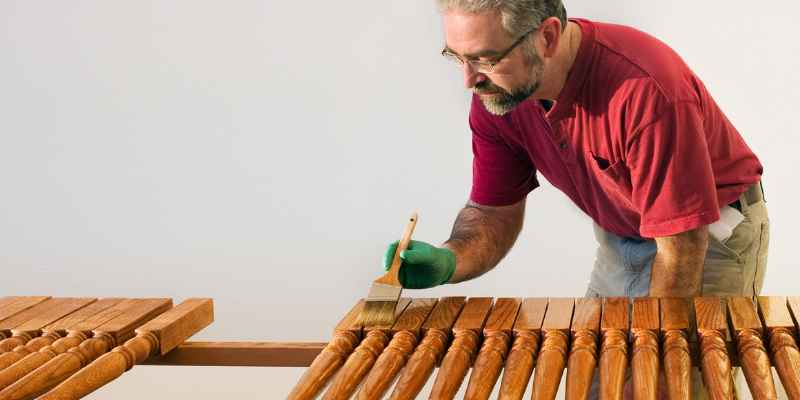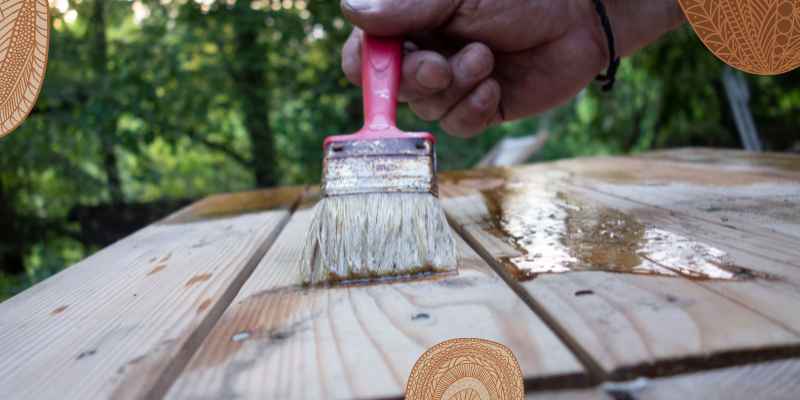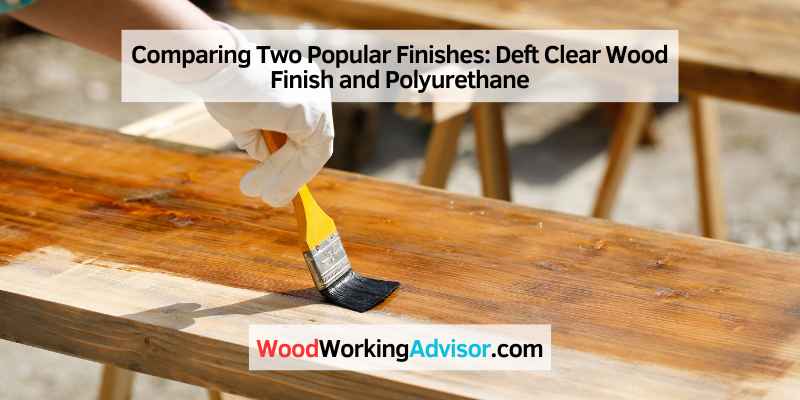When choosing a clear finish for your woodworking project, you have two main options: polyurethane or deft clear wood finish. Both finishes have pros and cons, so choosing the one that best suits your needs are essential.
When choosing a clear wood finish, there are two main options: polyurethane and deft clear wood finish. Both of these finishes provide a high level of protection for your wood surfaces and can give them a beautiful, glossy sheen. But which one is the best option for you?
Polyurethane is a synthetic resin that is durable and moisture-resistant. It can be applied in multiple coats to build a thick protective layer on wood surfaces. A deft clear wood finish is made from natural resins and provides similar protection against moisture and wear.
One advantage of polyurethane is that it dries quickly so you can apply several coats rapidly. The deft clear wood finish takes longer to dry but only needs one or two coats for complete protection. Polyurethane can turn yellow over time, so it’s not the best choice if you want your wood surfaces to maintain their natural color.
A deft clear wood finish will not be yellow and will help keep your wood looking new for longer. So, which one should you choose? If you want quick drying times and don’t mind the potential for yellowing, go with polyurethane.
If you want easy application and long-lasting protection without color change, go with a deft clear wood finish.

Lacquer Vs. Polyurethane
Regarding finishes for wood projects, there are two main types that people tend to use: lacquer and polyurethane. Both have unique benefits that can make them the right choice for different kinds of projects. Here’s a look at the key differences between these two finishes so you can choose the right one for your next project.
Lacquer is a thinner finish that dries quickly and provides a smooth, hard surface. It’s typically used on wood furniture or trim because it doesn’t require heavy sanding or prep work before applying. Polyurethane is a thicker finish that takes longer to dry but provides more durability and protection from scratches and wear.
It’s often used on floors or outdoor furniture because it can withstand more wear and tear than lacquer. So, which one should you use? It depends on the project you’re working on and your personal preferences.
Lacquer is a good option if you need a quick, easy-to-apply finish. If you’re looking for something more durable or your project will be exposed to lots of wear and tear, polyurethane would be a better choice.
Wood Lacquer Vs. Varnish
You have two main choices when protecting your wood surfaces: lacquer and varnish. Both products create a durable barrier that repels water and other liquids, but there are some critical differences between the two. Here’s a look at the pros and cons of each option to help you decide which is best for your needs.
Lacquer is a clear or pigmented coating that dries quickly and provides a high-gloss finish. It’s made from resins dissolved in solvents and can be applied with a brush, roller, or spray gun.
Lacquer is ideal for wood surfaces that will see heavy use, as it’s highly resistant to scratching and wear. It can also be easily repaired if it does become damaged. The main downside of lacquer is that it’s flammable while wet, requiring careful handling and ventilation during application.
It also has a strong odor that can be irritating to some people. And because it dries so quickly, lacquer can be tricky to work with if you’re not experienced using it. Varnish
Varnish is similar to lacquer in ingredients and application methods but dries more slowly and has a lower gloss level. Varnish is also less susceptible to damage from heat and sunlight than lacquer, making it a good choice for outdoor furniture or other exposed wood surfaces. However, the varnish isn’t as durable as lacquer overall, so it may need to be reapplied more often depending on how much wear and tear your surfaces see.
Polyurethane Vs. Varnish
If you are trying to protect your woodworking project, you may wonder which product is the best option: polyurethane or varnish. While both products can provide a good level of protection, there are some critical differences between the two that you should be aware of before making a decision. Polyurethane is more durable than varnish and will better resist scratches, scuffs, and other types of wear and tear.
However, it can turn yellow over time and is not as easy to repair if it does become damaged. Varnish is less durable than polyurethane but easier to touch if it becomes scratched or chipped. It also won’t yellow over time like polyurethane can.
So, which one should you choose? It depends on your specific needs and preferences. If you need a very durable finish that won’t show wear and tear easily, go with polyurethane.
If you want a finish that is easier to repair and maintain, the varnish may be your better option.
Lacquer Vs. Varnish Vs. Polyurethane
Deciding which clear coating to use on your woodworking projects can be difficult. Should you use lacquer, varnish, or polyurethane? They all have pros and cons, so it’s essential to understand the differences before deciding.
Lacquer is a fast-drying finish that can be applied in multiple thin coats. It dries hard and provides good protection against scratches and wear. Lacquer is also easy to repair if it gets damaged.
The main downside of lacquer is that it’s flammable and has a strong odor. Varnish is another popular option for woodworking projects. It takes longer to dry than lacquer, but it’s more durable and withstands heat better.
Varnish is also less likely to yellow over time. The main downside of varnish is that it can be challenging to apply evenly. Polyurethane is the most durable of the three options, but it’s also the most difficult to use correctly.
Polyurethane comes in both water-based and oil-based formulas. Water-based polyurethane dries faster, but oil-based polyurethane provides better protection against scratches and wear.
Polyurethane Wood Finish
Polyurethane wood finish is one of the most durable finishes available. It is also moisture resistant, making it ideal for protecting outdoor furniture and other exposed wood surfaces. Polyurethane can be applied as a clear finish or in various colors.
Polyurethane Vs. Polycrylic
When choosing a protective finish for your woodworking project, you have two main options: polyurethane and polyacrylic. Both finishes are transparent and durable, but there are some significant differences to remember when deciding. Polyurethane is a type of varnish that is derived from oil.
It is available in both water-based and oil-based formulas. Polyurethane provides a hard, durable finish that is resistant to scratches, stains, and fading. It can be applied with a brush or sprayed on and dried to a glossy finish.
Polycrylic is also a type of varnish, but it is made from acrylic resin instead of oil. Like polyurethane, it is available in both water-based and oil-based formulas. Polycrylic dries quickly and has a low odor, making it ideal for indoor use.
It provides a protective layer resistant to scratches and stains but will turn yellow over time if exposed to sunlight. So which one should you choose? Polyacrylic is the way to go if you need a quick-drying, low-odor option for an indoor project.
If you want maximum durability and scratch resistance, go with polyurethane. And if you can’t decide, try mixing both finishes!
Polyurethane Clear Coat
Polyurethane is a clear coat applied over paint or another finish to protect it from scratches, UV rays, and other environmental damage. It can be used by hand or spray gun and usually takes about 24 hours to cure. Polyurethane is more durable than different finishes like lacquer or varnish and can give your project a high-gloss finish.
Water-Based Polyurethane
Water-based polyurethane is a type of polyurethane that is made with water instead of oil. This makes it more environmentally friendly and safer to use than oil-based polyurethanes. Water-based polyurethane also dries faster and is less likely to yellow over time.
Is a Clear Finish the Same As Polyurethane?
No, a clear finish is not the same as polyurethane. While both are clear finishes that can be applied to wood, there are some critical differences between the two. Polyurethane is a synthetic resin that cures to form a hard, durable finish.
It is more resistant to scratches and wears than a clear finish, making it ideal for high-traffic areas or surfaces that will be used. Polyurethane can also yellow over time, so it’s essential to consider this when choosing a finish for your project. On the other hand, clear finishes are typically made from natural resins like shellac or lacquer.
They offer less protection than polyurethane but can be reapplied more quickly. Clear finishes can also provide a softer, more natural look to wood projects.

What is the Difference between Polyurethane And Wood Finish?
Polyurethane and wood finish are two different types of finishes that can be applied to wood. Polyurethane is a clear finish used over the top of the wood, while the wood finish is applied directly to the wood. Polyurethane provides a durable, protective layer that will keep the wood looking new for longer.
The wood finish does not provide as much protection but can enhance the look of the wood and give it a more natural appearance.
Is It Better to Use Lacquer Or Polyurethane?
If you are looking for a durable finish for your woodworking project, you may wonder if it is better to use lacquer or polyurethane. While both can provide a long-lasting and beautiful finish, there are some critical differences between the two that you should be aware of before making your decision. Lacquer is a clear or colored varnish that dries quickly and can provide a high-gloss finish.
It is made from synthetic resins dissolved in solvents and can be brushed or sprayed. Lacquer is typically used on furniture, cabinets, and trim work. Polyurethane is also a clear or colored varnish, but it dries more slowly than lacquer.
It is made from synthetic resins and hardens to form a tough, durable film. Polyurethane can be brushed or sprayed on and is often used on floors, decks, and outdoor furniture. One advantage of lacquer over polyurethane is that it dries more quickly, so you can complete your project in less time.
Lacquer also has a higher gloss than polyurethane, giving your project a shiny appearance. However, color is more susceptible to damage from household cleaners and abrasives than polyurethane. Polyurethane has several advantages over paint as well.
First, it forms a more rigid surface resistant to scratches and wears and tear. Additionally, polyurethane does not yellow over time like lacquer can (although both finishes will darken slightly with age). And finally, polyurethane can be removed with paint strippers if necessary; once the lacquer has cured, it cannot be removed without damaging the underlying wood surface.
. So which one should you choose?
What is the Most Durable Clear Finish for Wood?
Several finishes can be applied to wood to protect it from wear and tear; each has advantages and disadvantages. The most durable clear finish is polyurethane, a synthetic resin that forms a hard, protective film over the surface of the wood. Polyurethane is available in water- and oil-based formulations and can be applied with a brush or sprayer.
However, it takes several hours or even days to cure completely, so it’s not the best choice for projects that need to be completed quickly. Other durable clear finishes include lacquer and varnish, but these are more difficult to apply evenly and don’t provide as much protection as polyurethane.
Conclusion
Polyurethane is a clear finish that is typically used on wood floors. It can be applied as a topcoat over stained or painted surfaces and protects from scratches and wear. Deft Clear Wood Finish is a water-based polyurethane that dries quickly and leaves a durable, high-gloss finish.
It can be used on indoor and outdoor furniture and is ideal for use in high-traffic areas.



7 thoughts on “Comparing Two Popular Finishes: Deft Clear Wood Finish and Polyurethane”